At Indiegogo, we want to give current and future campaigners as many resources and insights into the crowdfunding process as possible. We believe that with more knowledge comes better performance, and for our campaigners, better performance means a giant leap toward making their idea a reality. When we saw Tina Tseng’s campaign diary, which gives an in-depth breakdown of how she and her team got their campaign to its goal, we knew that it would be great to share with the Indiegogo community.
Hi! My name is Tina and I am the CFO of Empathy FX, a nonprofit that raises funds to support our school in Ghana. I want to tell the story of our campaign on Indiegogo. You’ll hear all the nitty gritty details: like the tips Yan Budman, Indiegogo’s Director of Marketing, passed on to me, how our team laid out our social marketing plans, our pitch page details, and much more. I’ll spill what worked well for us and what could have been done better.
I’ll start by discussing the foundation we laid for the campaign, the communication methods my team used, and the considerations we had for building our pitch page. Then, I will discuss the marketing strategies that were most effective. Interspersed throughout this post will be sections titled “What We Learned,” describing lessons taught through the actions most recently described. My goal is to help future campaign owners succeed on Indiegogo.
To begin, I’d like to introduce the premise of Empathy FX: We are a nonprofit venture that sustains a school in Ghana through a variety of fundraising efforts, predominantly apparel sells and fundraising events like our recent inner beauty pageant. We decided to try crowdfunding on Indiegogo because we believed that Indiegogo would be the best platform to help us raise the necessary funds to buy and send supplies for a trip we’re taking to our school in Ghana this winter.
Part 1: Laying the Foundation
The team at our typical Tuesday night meeting.
Shortly after deciding to start a campaign on Indiegogo, the Empathy FX team laid out a solid foundation for the campaign. We wanted to discuss the foundation in person during our weekly meeting rather than resort to less efficient email. Here are the simple bare necessities we discussed:
1. What we want to raise money for and how much we were aiming to raise
Our winter travel program immediately jumped out as a great cause that we knew people could relate to and support. After all, we were going to send around ten volunteers to build on our school, teach our students, and be ambassadors to Ghana for the US chapter of our company. That’s a huge milestone in terms of Empathy’s goals and extremely in need of funding. Based on our travel costs and the other fundraising initiatives we knew we were going to undertake, $2,000 was a solid goal. The Indiegogo Blog Insights post Setting a Higher Goal Doesn’t Always Mean More Money was especially helpful in coming up with a good goal amount.
2. How we were going to get the eye-candy: the pitch page video and media
We knew we wanted a video and lots of media. While not necessary, campaigns with these media details are more likely to be successful. These things can be the most time-consuming part of creating a campaign, so we had this sorted out ASAP. Our well-connected Chief Programs Director Josh Wong immediately came up with a couple people whose video-making prowess he admired. He contacted them right away to see if either would join our cause. Meanwhile, our CEO Rosemary contacted our CEO in Ghana, Nana Aggrey Finn, for pictures and videos of our school and students.
3. Our social media strategy
We immediately highlighted three key areas of social media: Facebook, Twitter, and blogging. Three of us were assigned to something to update regularly. An employee, Stephen, is very active on Facebook, so he was given that to manage. Another employee, Phil, was assigned Twitter because he was active in this area. I received blogging, which was great because I enjoy writing. Our jobs all suited what we liked to do or what we were good at, so it worked out perfectly.
What We Learned: It’s important to figure out if fundraising is right for you or your organization. Is your organization at a place where it is ready to grow? Do you have a story that people can relate to? Is everyone on your team on board and ready to pull their weight? We answered yes to every question… so we went for it.
What was critical was having the whole team there: this allowed us to explain what crowdfunding is to those not in the know, offer ideas of perks and marketing strategy, and assign roles. Communication at this early stage put everyone on the same page.
Also, it is very helpful to establish first what the specific goal for your campaign is, especially if your organization has many initiatives concurrently occuring. We didn’t decide right off the bat, and it made discussion confusing until this was remedied.
Part 2: Methods of Communication
We found it quite important to have some commonly agreed-upon and easily accessible means of communication. Here’s what my team used:
1. Facebook
A sneak peek of our private exec team Facebook group. Here we post ideas, findings, and designs. It also makes it easy to give input.
What would a young crowd like us do without Facebook? Productive things, probably. Just kidding–in all seriousness, Facebook is the it way to communicate. So many people are already on it, and it lets you post up pictures and videos to share with your team members. For Empathy FX, we have a public page, a group for members (including past and present members), and a private group just for the execs. The page is used for promoting our cause, and the groups are for internal communication.
2. Email
This illustrates some of our practices– like heading emails with [EFX] and using a mailing list service.
Email, of course, is necessary for longer messages. One practice we have is to type “[EFX]” before the actual subject in the subject line. For example, “[EFX] Indiegogo Planning” would be what we put in the subject line of the email. That [EFX] allows our team to quickly see that the email is about Empathy FX, a surprisingly helpful step since everyone has so many different activities happening in their lives. We also have a mailing list just for our team to prevent having to copy and paste email addresses for every email.
3. Google Drive & DropBox
A part of our communication info doc on Google Drive! Everyone can access it and edit it to add their own information.
We keep most of our files on these cloud storage systems. Example: on Google Drive/Google Doc, we have a spreadsheet with everyone’s contact information. Good-bye, easily-misplaced-paper-records-of-phone-numbers! Now everyone can easily access the information online. We also created a Google Doc word document on which to plan our campaign. It’s easily shared and quickly editable, perfect for a large team like ours.
What We Learned: The tricky part is getting everyone on the same page. If someone doesn’t have DropBox and that’s your designated cloud storage of choice, there’s going to be some confusion. We learned quickly to list out all these methods of communication first during a meeting so that everyone knows what’s up and can download anything necessary to keep up with the rest of the team.
Part 3: Perfecting the Pitch Page
1. Pitch Page Information
First of all, definitely read Indiegogo Blog Insight’s 5 Basic Elements for a Great Pitch Page. In the article are links to great examples of other campaigns that were definitely helpful to determining what we needed in ours.
For us, we narrowed down the categories we needed to talk about to:
The Scene: First, we wanted to just describe our school. We wanted a space to give a sense of what our school in Ghana looks like and hopefully convey a sense of our passion.
With Your Help…: This is where we describe (very generally) what the funds will be used for. We also described the two choices for one of our perks (t-shirts) that funders have to pick from.
Schedule & Objectives: Here we wanted to lay out more specifically what exactly we would be doing with the money; in our case, we were going to be traveling to Ghana to work on our school, so we talked about our schedule and goals for that.
Where Your Funds Go: Now for a specific breakdown of where the money goes. We used percentages to give funders an idea of how their money would be used.
Who We Are: Now to say more about ourselves! We described a little of our history here and what we stand for.
Our Team: Each team member wrote a little blurb about themselves and why we are passionate about Empathy FX.
Thank You: Of course, we want to convey our appreciation every chance we get, so here we made sure to strike home why donating will truly lead to a huge difference in our students’ lives.
Other Ways to Support Us: We completely understand that monetary support isn’t always feasible for even our most ardent supporters, so we described other ways to help us in our journey; namely, liking us on Facebook, following us on Twitter, and checking out our blog and website.
Contact Us: Here we left an email for feedback.
2. Perks
A description of our t-shirt perk on our pitch page.
When choosing our perks, we picked some relevant to the cause the money was going towards (postcards featuring a picture of our students in Ghana, items donated in people’s names, etc). Because Empathy FX has sold apparel in the past, we went for t-shirts as one of our main perks. Check out this article for some great pricing statistics–you’ll find that $25 and $100 are great price points to choose. I also looked around at many other similar campaigns to get a good idea of what perks to pick.
Make sure you check out what you can and can’t offer as a perk here!
What We Learned: Definitely go through the Indiegogo Insight blog and support articles for great tips!
Part 4: Steps to Success
Now that the foundation of the campaign, the methods of communication, and the pitch page details have been finalized, it was time to dive into our marketing strategies. Here are the exact steps we took to formulate and execute our plans.
Step 1: Talk to Indiegogo
Thankfully, one of the business clubs on our campus was holding a speaker panel for social media marketing experts… and Indiegogo was going to be represented by Yan Budman, Director of Marketing. The moment I heard about that, I knew I had to go. Who better to talk to than someone like Yan?
He was extremely helpful, as were other members of the team, and everyone I’ve talked to so far has made my experience with Indiegogo a wonderful one. They linked me to several interesting articles that were very helpful in coming up with our marketing game plan, patiently answered my many questions, and offered support–fantastic team!
Step 2: Social Media Marketing Plan
We had separate calendars to mark when we would be updating our Facebook, Twitter, blog, and pitch page!
Because everyone on our team is so busy, I wanted to make sure we kept track of our updates and that we actually do them. So I printed a few calendars for October and November (the months our campaign will run through) and designated each calendar to be for a social media platform. I then highlighted the days on each calendar where each social media platform should be updated. So far, this tactic has proven effective for keeping everybody on track, though I’ve found that people do need to be flexible as surprising circumstances arise.
What We Learned: From the Indiegogo guys–a lot! As mentioned earlier, make sure to read the Indiegogo Insights blog. It’s full of useful tips based in statistics from successful campaigns. Also, the calendars were helpful for delegating tasks, but as I mentioned earlier, use them with the acknowledgement that sometimes circumstances will change rapidly and everyone assigned to a marketing role needs to be ready to respond to these kinds of changes.
Step 3: The Facebook Event
A look at Empathy FX’s Facebook event for the campaign!
The quintessential Facebook event–no organization can get away with not creating a few of these for their activities! And there is good reason why not: it is extremely fast and easy inviting people to the event (as you can see, the members of our team collectively invited over 5000 people). It lets all those people know that something’s going on–even if not all of them read everything through carefully, they’ll gain some familiarity with it. And familiarity leads to a sense of camaraderie… which leads to support.
Here are some key aspects of this Facebook event that we felt was important to include:
- Link to the campaign. Don’t forget!
- Link to other ways to support the cause (such as your Facebook page, website, Twitter, blog, etc).
- Describe the cause briefly.
- Have an email for people to contact with any questions.
Things we should have included/done but forgot to (learn from our mistakes):
- Sneak peeks of our perks.
- Regular updates/posts to remind everyone of the event, since the event lasted for 40 days.
Step 4: Warm Leads
Our Google Drive spreadsheet with names of everyone’s top 10 warm leads to contact.
As effective as Facebook is for blasting a ton of people with a notification about your cause, it’s not exactly the most personal marketing initiative. It’s great for spreading awareness, but when it comes to actually educating people about our cause and bringing in that funding, we knew Facebook could only go so far. Hence, warm leads! Here’s what this is about:
We wanted everyone on the team to personally reach out to their top ten contacts (their closest friends and family) about the campaign, whether through email or messaging–whatever works best with that particular person.
To better organize this effort, encourage accountability, and have everyone else’s progress be a motivating factor, I created a Google Drive spreadsheet. On the first row, I put the names of every person in the company. On the first column, I numbered off rows from 1-10 . I then froze the first row and first column (View > Freeze Rows > Freeze 1 Row and View > Freeze Columns > Freeze 1 Column) so that even though the spreadsheet was big and had to be scrolled to reach some rows, some info like the names and numbers would stay in place.
I made a key so everyone knew how to keep track of who they’ve contacted, and then I shared the spreadsheet with everyone in the group. We then started filling out names of our top ten contacts and shaded each cell grey once that person has been contacted!
I provided an email template for those who wanted that help. We did encourage everyone to personalize all their communication though; the template is mainly for easy copy and pasting of the main links (to the campaign, website, Twitter, blog).
What We Learned: Facebook is great for rapidly spreading awareness, but turn to more personal communication for real results! Remember to constantly update your Facebook event if you want more eyeballs on that page. Also, organizing the warm leads contacts into an easily accessible shared spreadsheet online kept everyone accountable, organized, and motivated.
5. Reaching Out
In addition to the warm leads we discussed in Part 4: Adventures in Marketing, we wanted to reach out to groups that might find our cause of interest. A main reason why I wanted to reach out to these groups is the advice that their experience can offer us. As a newer, student-run nonprofit, we felt that there was much to learn from the wiser gurus in older nonprofits. We researched organizations that had similar causes to ours (based in Ghana, focusing on education, etc) and asked for advice and support. We also asked mentors who have held successful crowdfunding campaigns.
We received some kind replies:
Eric Meltzer of The Open Company gave great advice regarding nonprofits, campaigns, engagement, and more.
Kyakagunga Primary School offered tips regarding their successful Indiegogo campaign.
Dream Ghana Foundation welcomed our idea of a partnership.
Other nonprofits offered to discuss our initiatives further and even meet up with us in Ghana! Overall, we were touched by the responses we received.
6. The Last Push
The last push meeting! A couple VERY productive hours.
Something to be aware of: if your campaign is anything like ours, there will be some stressful moments. Not many, but there will be some times when you worry about ever reaching your goal. There might be some white hairs involved. But it’s perfectly normal: here’s what happened with us:
Three days before the end of our campaign, we were still a few hundred shy of our goal. I decided to throw an Indiegogo last push hang out/bonding event where everyone on the team came together to chat, chill, eat snacks, and push our campaign through chat and texts to everyone they could. Most of our work had been done individually in the past, so I hoped that being together would help make the work more enjoyable for everyone.
It worked–our team always had great chemistry, so any time we get together is guaranteed to contain plenty of laughter and jokes. Our CEO Rosemary offered prizes for the first employee to receive a donation for the night and the employee who gets the largest donation of the night. We had plenty of chips and Caprisun. We played music and sang along. And we made $500 in an hour.
What We Learned: If you’re at a stage of your campaign where you are feel anxious about how much you’ve raised, my advice is first remind yourself of what you’ve gained–publicity, some funding at the very least, and a healthy dose of love from your family and friends. Then get everyone together for a party and make that last push. People love donating in the last few days, so don’t lose hope!
We ultimately raised $2375 of our $2000 goal, but what I found most rewarding about the entire process was the amount of support that family and friends accorded us. The kindness and generosity we faced over the last forty days of our campaign was truly heartwarming.
We hope the information presented in this post has been helpful in any way. If you have any questions or concerns, never hesitate to email us at empathyfxinternational (at) gmail.com. You can also reach me personally: tina (at) empathyfx.org. We have truly enjoyed presenting this series!
A last note: Crowdfunding began as a rapidly spreading trend, and now it is a staple of the Internet culture. Now full-fledged companies and products can attribute their beginnings to a humble pitch page on Indiegogo. Empathy FX International is prouder than we can say to be one of these companies.
We’d like to thank Tina and the EmpathyFX team for giving us this behind-the-scenes look into a successful crowdfunding a campaign! Thank her too and share these insights on Twitter!
4 Responses
You must be logged in to post a comment.
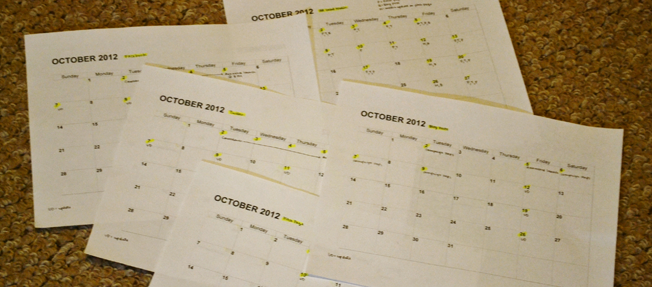
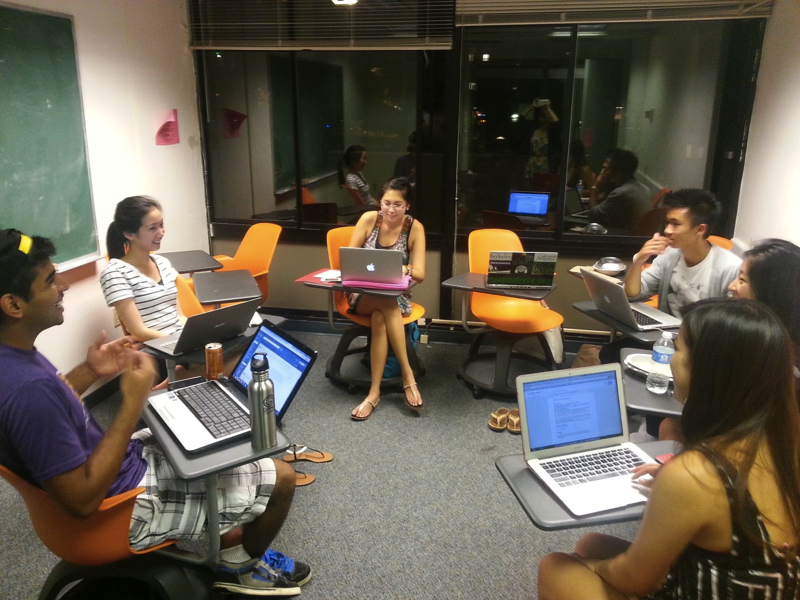

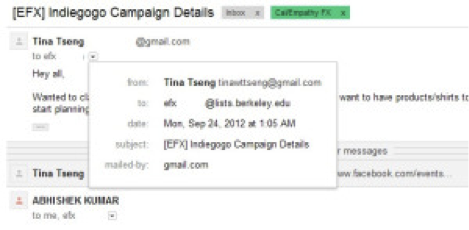
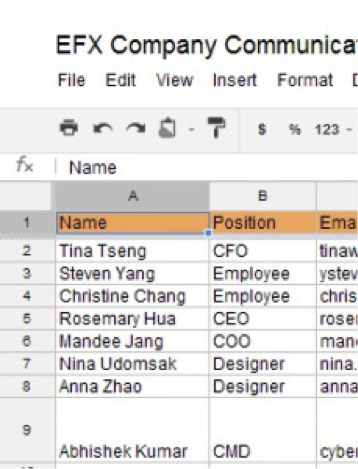
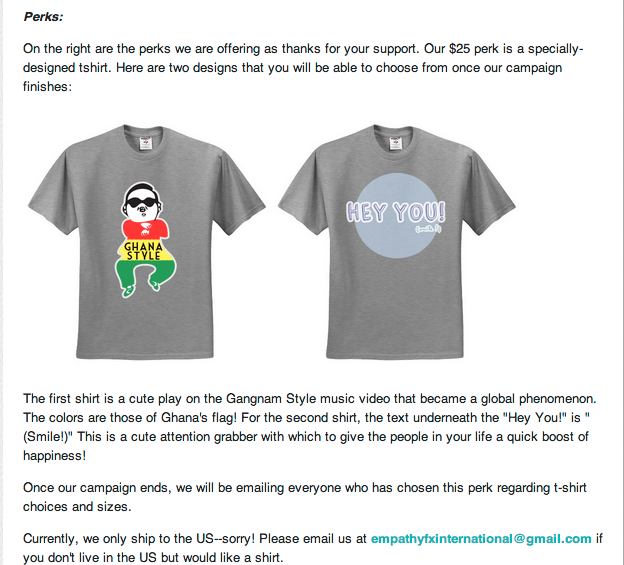
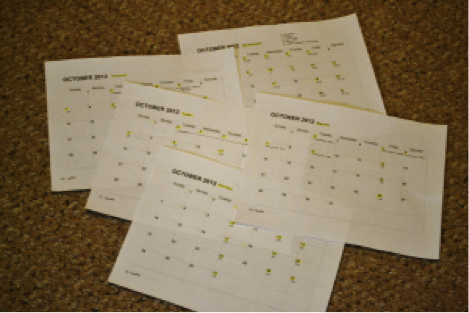
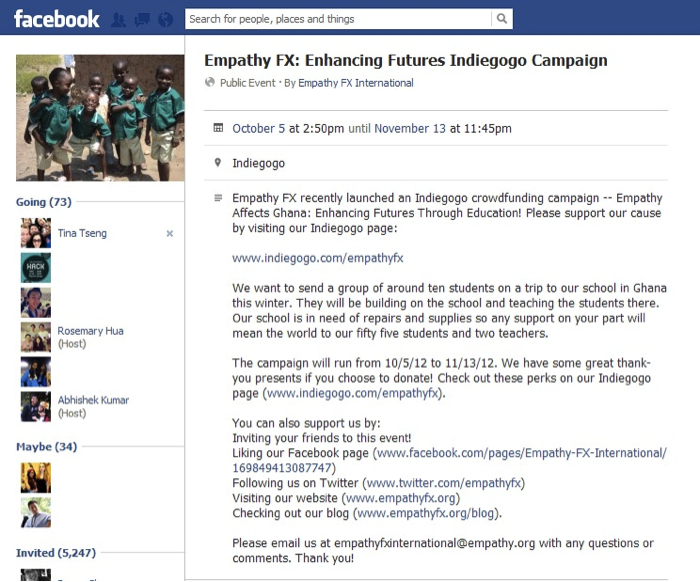
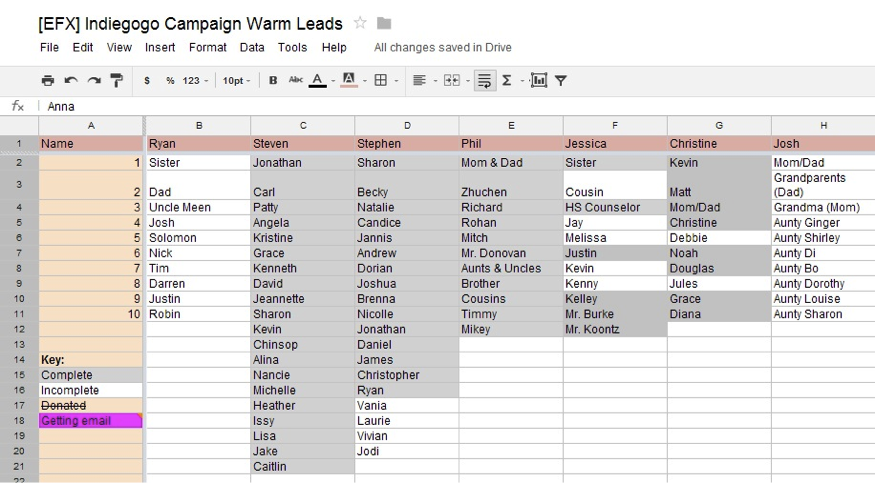


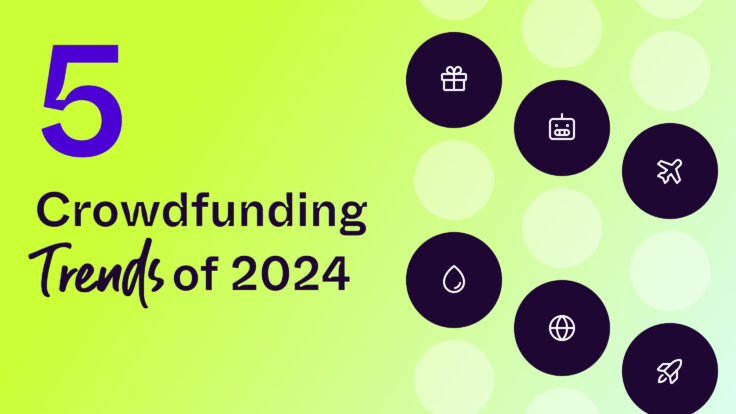
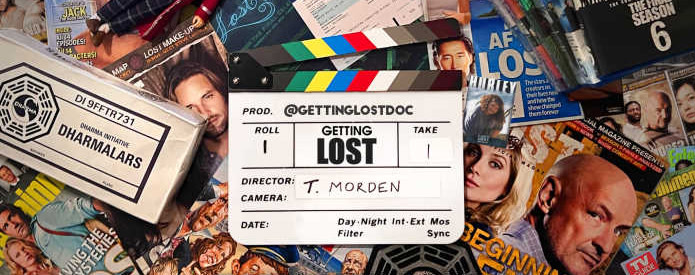
Thank you Tina. I appreciate you sharing the advice since I’m part of a campaign that just launched. I will definitely be sending personal e-mails to my top 10.
This is a nice piece of work, and it’s good to adhere to when carrying out crowdfunding.
nicely done!
Many things learned from this wonderful post by EmpathyFX! I wish your Team the best.